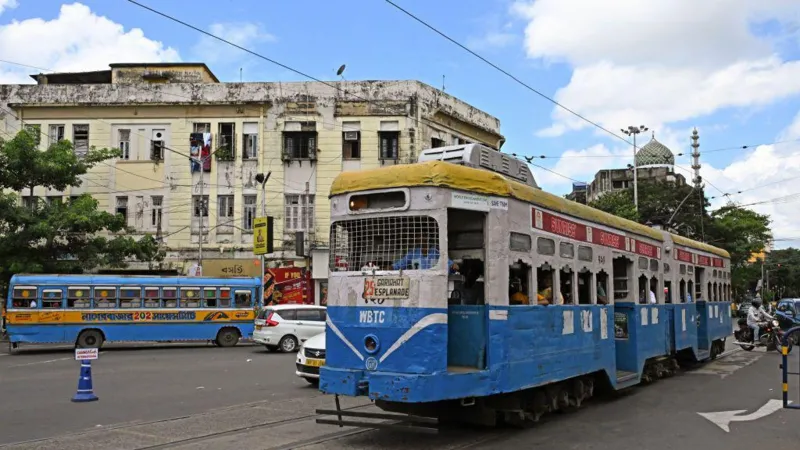Kolkata’s trams are in danger of disappearing as the city plans to remove them entirely, leaving just a small heritage route. The tram network has already shrunk from 52 routes in the 1970s to only three now. Activists are trying to save the trams, which they see as an important form of transport and not just a nostalgic ride.
Kolkata recently celebrated 150 years of its tram system with a fun event featuring vintage trams, including a wooden one that’s over 100 years old. Melbourne, like Kolkata, has one of the oldest tram systems, but unlike Kolkata, its trams are thriving. Melbourne has upgraded its system, and some trams even run on solar power.
In Kolkata, the tram cars are old and haven’t been updated in years, with signs warning about pickpockets and instructions for passengers that haven’t changed since the past.
The government wants to remove most of the trams, but activists argue that keeping them is vital for a city focused on climate change and reducing carbon emissions.
Activists like Roberto D’Andrea, who promotes the friendship between Kolkata and Melbourne’s tram systems, emphasize that many cities worldwide are rebuilding tram systems after removing them. He believes trams are an essential part of Kolkata’s identity and should be preserved.
West Bengal’s transport minister Snehasis Chakraborty pointed out that Kolkata’s roads haven’t expanded to accommodate its growing population and vehicle count.
In contrast, cities like Mumbai and Delhi, which once had tram systems, have done away with them, leaving Kolkata as the only city in India with trams.
Trams are not just a mode of transportation in Kolkata; they’re part of the city’s culture. They are featured in films, and their sound is familiar to many residents.
For example, the film “Mahanagar” by Satyajit Ray opens with a stunning tram sequence that reflects the city’s essence.
Historically, trams connected various parts of Kolkata, and during times of unrest, tram workers helped maintain peace. Gopal Ram, a tram driver, shared that his family has been involved with trams for generations.
Despite their long history, trams have faced challenges, especially with the rise of personal cars. However, transport consultant Suvendu Seth argues that cities worldwide are rediscovering the benefits of tram systems. He believes that instead of eliminating trams, the government could have created pedestrian-only streets to preserve them.
Trams have also been an important link in Kolkata’s history, being the first city in Asia to introduce electric trams in 1902. However, as car usage increased in the 1990s, the government labeled trams as “obsolete.”
Activists are now using culture to save trams. They hold events like the Tramjatra festival, where local artists perform and paint trams, attracting younger generations to the tram culture.
Some tram routes have been reopened recently, and there have been attempts to make trams more appealing, such as creating tram libraries.
In 2019, Kolkata was recognized for its green transportation plans, which included expanding its tram network.
However, the current government seems to be focusing on electric buses and other options instead.
Activists believe that trams have been overlooked for their potential and that they are losing ground to tuk-tuks, which the government prefers for employment and political reasons.
Despite the uncertainty, the future of Kolkata’s trams is under review by the Calcutta High Court, which is considering ways to maintain and restore tram services.
Retired tram worker Subir Bose feels that the government has hesitated to shut down the trams because they are part of Kolkata’s identity.
He said, “Three things made Kolkata Kolkata – the Howrah Bridge, the Victoria Memorial, and the trams. It’s heart-breaking to think we could be losing one of them.”
This situation highlights the struggle between modern transportation needs and the preservation of cultural heritage, as reported by the BBC.
https://www.bbc.com/news/articles/ckgn4mzn224o

